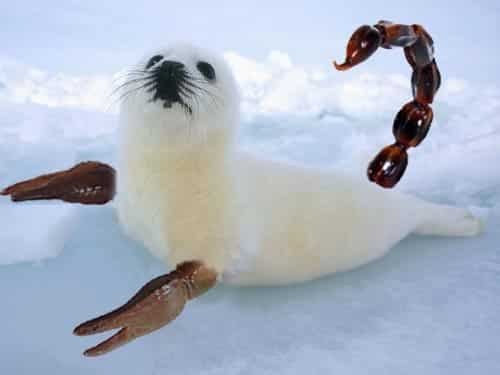Iqaluit, Nunavut (April 01, 2010) –
As Arctic winters become increasingly warmer, retreating glaciers in the Canadian North begin to reveal previously unknown forms of life. Reclusive species, which have successfully hidden themselves from human view for thousands of years, are being observed by scientists for the first time.
While evidence of global warming is met with alarm by the scientific community in general, arctic biologists could barely contain their enthusiasm when eyewitness reports confirmed the existence of the scorpion seal. Once thought to be a mythical creature with roots in native folklore, the scorpion seal combines the strength and speed of the scorpion, with the soft cuddly qualities of the harp seal.
Initial evidence suggests that the scorpion seal is the first known mammaliancrustacean. Dr. Richard Neverlapel of the Arctic Wildlife Foundation says, “The scorpion seal seems to exhibit the qualities of both warm and cold blooded animals. Like lizards and amphibians, the scorpion seal enters a state of suspended animation, or stasis, in which it can remain motionless for up to 49 days in total darkness. Yet unlike its cold blooded cousins in the crustacean family, the scorpion seal maintains a piping hot body temperature of 108 degrees fahrenheit.”
While biologists marvel at this newly found species, environmental groups are calling the discovery an important wakeup call. “We are delighted to learn of the scorpion seal,” said environmental spokesperson Sir M. Warriorwitz in a recent press conference. “But it’s important to reflect on the causes and conditions that brought this knowledge to light.” Sir Warriorwitz went on to say, “We will move forward to save not only the scorpion seal and its habitat, but will continue our work until we have saved the entire world.”










